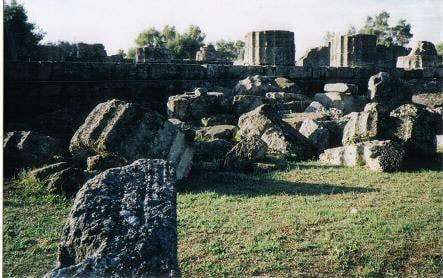Ancient Olympia
Template:Infobox Town GR
Olympia (Greek: Ολυμπία Olympí'a or Ολύμπια Olýmpia, older transliterations, Olimpia, Olimbia), a sanctuary of ancient Greece in Elis, is known for having been the site of the Olympic Games in classical times, comparable in importance to the Pythian Games held in Delphi. Both games were held every olympiad (i.e. every four years), the Olympic Games dating back possibly further than 776 B.C.E. In 394 emperor Theodosius I, or possibly his grandson Theodosius II in 435, abolished them because they were reminiscent of paganism.
The sanctuary itself consists of an unordered arrangement of various buildings. To the north of the sanctuary can be found the prytaneion and the Philippeion, as well as the array of treasuries representing the various city states. The metroon lies to the south of these treasuries, with the Echo Stoa to the East. To the south of the sanctuary is the South Stoa and the Bouleuterion, whereas the West side houses the palaistra, the workshop of Pheidias, the Gymnasion and the Leonidaion. Enclosed within the temenos are the temples of Hera and Zeus, the Pelopion and the area of the altar, where the sacrifices were made. The hippodrome and later stadium were also to the East.
Olympia is also known for the gigantic ivory and gold statue of Zeus that used to stand there, sculpted by Pheidias, which was named one of the Seven Wonders of the Ancient World by Antipater of Sidon. Very close to the temple of Zeus (see photo of ruins below) which housed this statue, the studio of Pheidias was excavated in the 1950s. Evidence found there such as sculptor's tools, corroborates this opinion.
Excavation of the Olympia temple district and its surroundings began with a French expedition in 1829. German archaeologists continued the work in the latter part of the 19th century. The latter group uncovered, intact, the Hermes of Praxiteles statue, among other artifacts. In the middle of the 20th Century, the stadium where the running contests took place was excavated.
The Olympic flame of the modern-day Olympic Games is lit by reflection of sunlight in a parabolic mirror at the restored Olympia stadium and then transported by a torch to the place where the games are held.
When the modern Olympics came to Athens in 2004, the men's and women's shot put competition was held at the restored stadium.
The ancient ruins sits north of the Alfeios River and lies next to Cronius or Kronios hill (the hill of Kronos, or Saturn). Kladeos, a tributary of Alfeios, flows around the area.
The town has a school and a square (plateia). Tourism is popular throughout the late-20th century. The city has a train station and is the easternmost terminus of the line of Olympia-Pyrgos (Ilia). The train station which the freight yard is west of it is about 300 m east of the town centre.
It is linked by GR-74 and the new road was opened in the 1980s, the next stretch N and NE of Olympia will open in around 2005. Distance from Pyrgos is 20 km E(old: 21 km), about 50 km SW of Lampeia, W of Tripoli and Arcadia and 4 km north of Krestena and N of Kyparissia and Messenia. The highway passed north of the ancient ruins.
A reservoir is located 2 km southwest damming up the Alfeios river and has a road from Olympia and Krestena which in the late-1990s has been closed.
The area is hilly and mountainous, most of the area within Olympia is forested.
Nearest Places
- Varvasena (west)
Subdivision:
- Drouva
Communes:
- Ancient Pisa (Miraka)
- International Olympic Academy (pop: 63)
- Aspra Spitia
- Ypsilo
- Chelidonio
- Floka
- Irakleia
- Kafkonia
- Kamena
- Nea Kamena
- Vasilaki
- Kladeos
- Koskina
- Fanara
- Kryonero
- Linaria
- Louvro
- Gyros
- Mageira
- Mouria
- Pefko
- Pelopio
- Ampari
- Platanos
- Agios Georgios (pop: 7)
- Pournario
- Smila
- Kourouta
- Strefi
- Kato Strefi (Flokeika)
- Xirokampos
Historical population:
| Year | Communal population | Change | Municipal population | Change |
|---|---|---|---|---|
| 1981 | 1,125 | - | - | - |
| 1991 | 1,742 | -349/-4.87% | 11,229 | - |
| 2001 | 1,475 | -267/-15.33% | 11,069 | -160/1.42% |
External links
- The Official Website of Olympia, Greece
- Harry Thurston Peck, Harper's Dictionary of Classical Antiquities, (1898): "Olympic Games"
- traveljournals.net - Olympia
- Olympia photos and info
- traveljournals.net/explore/greece/map/m1214007/olimbia_arkhaia traveljournals.net - Ancient Olympia
- GTP - Ancient Olympia
- GTP - Municipality of Ancient Olympia
- GTP - Ancient Olympia
- Olympia photo gallery
- Indexmundi - Olympia
- Olympia - extensive black and white photo-essays of the site and related artifacts
| North: Foloi | ||
| West: Pyrgos |
Olympia | East: |
| South:Skillounta, Alifeira |
See also
- Communities of Ilia
Credits
New World Encyclopedia writers and editors rewrote and completed the Wikipedia article in accordance with New World Encyclopedia standards. This article abides by terms of the Creative Commons CC-by-sa 3.0 License (CC-by-sa), which may be used and disseminated with proper attribution. Credit is due under the terms of this license that can reference both the New World Encyclopedia contributors and the selfless volunteer contributors of the Wikimedia Foundation. To cite this article click here for a list of acceptable citing formats.The history of earlier contributions by wikipedians is accessible to researchers here:
The history of this article since it was imported to New World Encyclopedia:
Note: Some restrictions may apply to use of individual images which are separately licensed.
